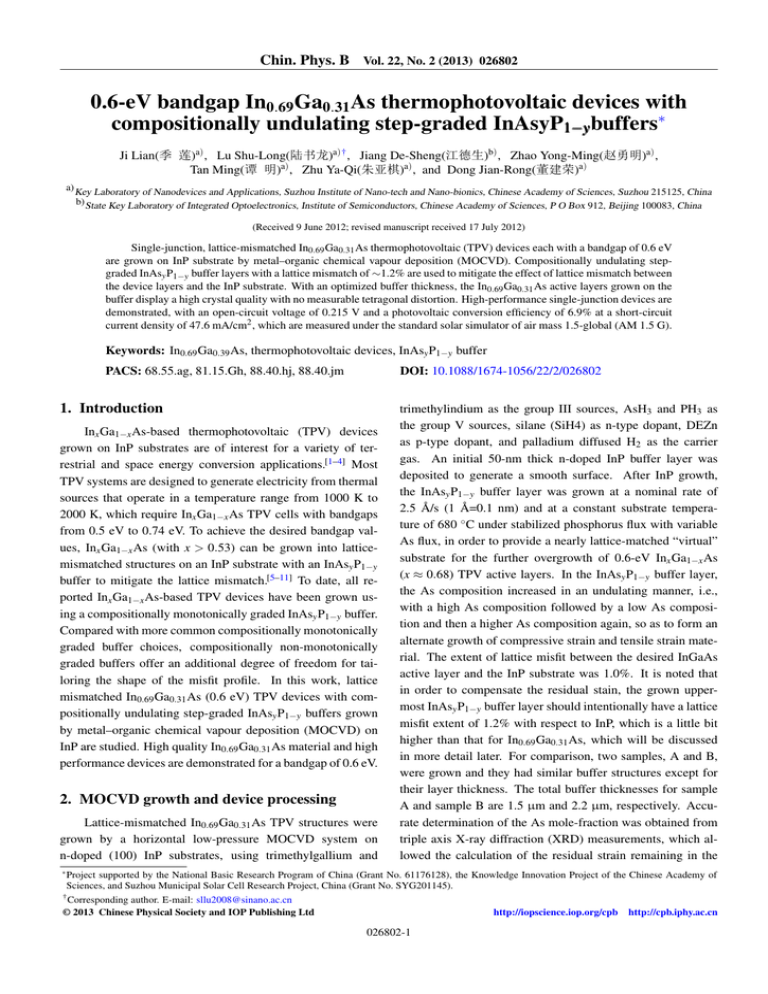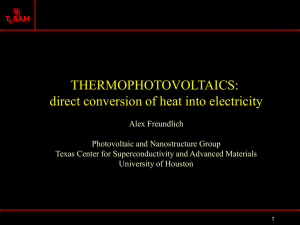0.6-eV bandgap In0.69Ga0.31As thermophotovoltaic
advertisement

Chin. Phys. B Vol. 22, No. 2 (2013) 026802 0.6-eV bandgap In0.69Ga0.31As thermophotovoltaic devices with compositionally undulating step-graded InAsyP1−ybuffers∗ Ji Lian(季 莲)a) , Lu Shu-Long(陆书龙)a)† , Jiang De-Sheng(江德生)b) , Zhao Yong-Ming(赵勇明)a) , Tan Ming(谭 明)a) , Zhu Ya-Qi(朱亚棋)a) , and Dong Jian-Rong(董建荣)a) a) Key Laboratory of Nanodevices and Applications, Suzhou Institute of Nano-tech and Nano-bionics, Chinese Academy of Sciences, Suzhou 215125, China b) State Key Laboratory of Integrated Optoelectronics, Institute of Semiconductors, Chinese Academy of Sciences, P O Box 912, Beijing 100083, China (Received 9 June 2012; revised manuscript received 17 July 2012) Single-junction, lattice-mismatched In0.69 Ga0.31 As thermophotovoltaic (TPV) devices each with a bandgap of 0.6 eV are grown on InP substrate by metal–organic chemical vapour deposition (MOCVD). Compositionally undulating stepgraded InAsy P1−y buffer layers with a lattice mismatch of ∼1.2% are used to mitigate the effect of lattice mismatch between the device layers and the InP substrate. With an optimized buffer thickness, the In0.69 Ga0.31 As active layers grown on the buffer display a high crystal quality with no measurable tetragonal distortion. High-performance single-junction devices are demonstrated, with an open-circuit voltage of 0.215 V and a photovoltaic conversion efficiency of 6.9% at a short-circuit current density of 47.6 mA/cm2 , which are measured under the standard solar simulator of air mass 1.5-global (AM 1.5 G). Keywords: In0.69 Ga0.39 As, thermophotovoltaic devices, InAsy P1−y buffer PACS: 68.55.ag, 81.15.Gh, 88.40.hj, 88.40.jm DOI: 10.1088/1674-1056/22/2/026802 1. Introduction Inx Ga1−x As-based thermophotovoltaic (TPV) devices grown on InP substrates are of interest for a variety of terrestrial and space energy conversion applications.[1–4] Most TPV systems are designed to generate electricity from thermal sources that operate in a temperature range from 1000 K to 2000 K, which require Inx Ga1−x As TPV cells with bandgaps from 0.5 eV to 0.74 eV. To achieve the desired bandgap values, Inx Ga1−x As (with x > 0.53) can be grown into latticemismatched structures on an InP substrate with an InAsy P1−y buffer to mitigate the lattice mismatch.[5–11] To date, all reported Inx Ga1−x As-based TPV devices have been grown using a compositionally monotonically graded InAsy P1−y buffer. Compared with more common compositionally monotonically graded buffer choices, compositionally non-monotonically graded buffers offer an additional degree of freedom for tailoring the shape of the misfit profile. In this work, lattice mismatched In0.69 Ga0.31 As (0.6 eV) TPV devices with compositionally undulating step-graded InAsy P1−y buffers grown by metal–organic chemical vapour deposition (MOCVD) on InP are studied. High quality In0.69 Ga0.31 As material and high performance devices are demonstrated for a bandgap of 0.6 eV. 2. MOCVD growth and device processing Lattice-mismatched In0.69 Ga0.31 As TPV structures were grown by a horizontal low-pressure MOCVD system on n-doped (100) InP substrates, using trimethylgallium and trimethylindium as the group III sources, AsH3 and PH3 as the group V sources, silane (SiH4) as n-type dopant, DEZn as p-type dopant, and palladium diffused H2 as the carrier gas. An initial 50-nm thick n-doped InP buffer layer was deposited to generate a smooth surface. After InP growth, the InAsy P1−y buffer layer was grown at a nominal rate of 2.5 Å/s (1 Å=0.1 nm) and at a constant substrate temperature of 680 ◦ C under stabilized phosphorus flux with variable As flux, in order to provide a nearly lattice-matched “virtual” substrate for the further overgrowth of 0.6-eV Inx Ga1−x As (x ≈ 0.68) TPV active layers. In the InAsy P1−y buffer layer, the As composition increased in an undulating manner, i.e., with a high As composition followed by a low As composition and then a higher As composition again, so as to form an alternate growth of compressive strain and tensile strain material. The extent of lattice misfit between the desired InGaAs active layer and the InP substrate was 1.0%. It is noted that in order to compensate the residual stain, the grown uppermost InAsy P1−y buffer layer should intentionally have a lattice misfit extent of 1.2% with respect to InP, which is a little bit higher than that for In0.69 Ga0.31 As, which will be discussed in more detail later. For comparison, two samples, A and B, were grown and they had similar buffer structures except for their layer thickness. The total buffer thicknesses for sample A and sample B are 1.5 µm and 2.2 µm, respectively. Accurate determination of the As mole-fraction was obtained from triple axis X-ray diffraction (XRD) measurements, which allowed the calculation of the residual strain remaining in the ∗ Project supported by the National Basic Research Program of China (Grant No. 61176128), the Knowledge Innovation Project of the Chinese Academy of Sciences, and Suzhou Municipal Solar Cell Research Project, China (Grant No. SYG201145). † Corresponding author. E-mail: sllu2008@sinano.ac.cn © 2013 Chinese Physical Society and IOP Publishing Ltd http://iopscience.iop.org/cpb http://cpb.iphy.ac.cn 026802-1 Chin. Phys. B Vol. 22, No. 2 (2013) 026802 layers. Full details related to the growth and properties of the InAsy P1−y buffer are reported elsewhere.[12] The schematic cross section of a basic n–p–n TPV structure is shown in Fig. 1 which allows the use of the desired n-on-p cell configuration with an InGaAs tunnel junction as needed for monolithic interconnected module (MIM) TPV.[13] The active region of the cell consists of a p/n junction (base/emitter) of InGaAs surrounded by the layers of InAsP, which is used to passivate the high recombination-velocity InGaAs surface and confine the minority carriers, leading to an improved device performance.[14] The Ni/AuGe/Ni/Au metallization was used for the n-type Ohmic contact. An antireflection coating (ARC) of SiO2 /TiO2 was deposited on the top surface. For comparison, a lattice-matched In0.53 Ga0.47 As TPV device (sample C) with a bandgap of 0.73 eV was fabricated, which had the same structure as samples A and B except for no InAsP buffer layers. The size of each of the cell devices is 2.5 mm×2.5 mm. SiO2/TiO2 antireflection coating density and poorer crystal quality of sample A as confirmed by TEM analysis. For sample B, there are three distinct RLP maxima in the RSM, and the peaks corresponding to these RLP maxima are assigned to (i) the InP substrate, (ii) the uppermost InAsy P1−y buffer layer, and (iii) the In0.69 Ga0.31 As cover layer. The In0.69 Ga0.31 As layer RLP lies directly on the uppermost InAsy P1−y buffer layer, so its in-plane lattice constant is coherent with that of the uppermost InAsy P1−y layer, indicating that the internal lattice matching has been achieved between the In0.69 Ga0.31 As layer and the InAsy P1−y layer. In addition, the In0.69 Ga0.31 As layer RLP is exactly centred on the line extending between the substrate RLP and Q = 0, indicating that the In0.69 Ga0.31 As has reached their equilibrium cubic structure with no measurable tetragonal distortion, which is attributed to the fact that the uppermost InAsy P1−y buffer layer is grown up to a composition corresponding to a lattice constant of as = a1 + εa0 , overshooting the desired device lattice constant by a small amount εa0 ,[15] where a0 corresponds to InP lattice constant, a1 corresponds to the lattice constant of In0.69 Ga0.31 As, and ε corresponds to residual strain at the surface of the buffer layer. n++InGaAs contact 8.56 (a) n+InGaAs emitter 8.52 Qz/mm-1 nInGaAs windows PInGaAs base pInAsP back surface field p++InGaAs tunnel junction InP 8.48 8.44 8.40 n++InGaAs tunnel junction 8.36 n+InAsP buffer In0.69Ga0.31As relaxation line 2.30 2.34 2.38 2.42 Qx/mm-1 2.46 n+InP buffer 8.58 nInP substrate (b) 8.54 Qz/mm-1 InP Fig. 1. Cross section of the double heterostructure (InGaAs/InAsP) 0.6 eV TPV device grown on n-InP substrate. 8.50 8.46 In0.69Ga0.91As 8.42 3. Material characteristics The relaxation state and residual strain of the samples were checked by reciprocal space maps (RSMs) with asymmetric (115) reflection measured using high-resolution triple axis XRD as shown in Fig. 2. For sample A, the (115) RSM exhibits only two distinct reciprocal lattice point (RLP) maxima, one is for the substrate and the other is for the In0.69 Ga0.31 As layer, as shown in Fig. 2(a). The RLP of In0.69 Ga0.31 As layer exhibits a larger peak broadening compared with sample B, which is attributed to higher dislocation InAs0.37P0.63 8.38 8.34 relaxation 2.32 line 2.36 2.40 Qx/mm-1 2.44 Fig. 2. Asymmetric (115) RSMs of the In0.69 Ga0.31 As TPV device epitaxial layers grown on (001) InP substrate for (a) sample A, (b) sample B. According to the atomic force microscopy (AFM) measurements (not shown here), the expected crosshatch morphology that is characteristic of strain relaxation induced by 026802-2 Chin. Phys. B Vol. 22, No. 2 (2013) 026802 4. Device characteristics The current–voltage (I–V ) characteristic curves of latticematched (sample C) and lattice-mismatched (sample A and sample B) TPV devices under the standard solar simulator of air mass 1.5-global (AM 1.5G) are shown in Fig. 3. It is obvious that the short-circuit current density of the mismatched TPV device is larger than that of the matched TPV device due to the lower InGaAs bandgap. The calibration at 1 sun shows that the lattice-mismatched cell sample A has a photovoltaic conversion efficiency of 5.31% with an open voltage (Voc ) of 0.19 V, a short-circuit current density (Jsc ) value of 43 mA/cm2 , and a fill factor (FF) of 58%. The latticemismatched cell sample B has a better photovoltaic conversion efficiency (6.9%) with a higher Voc (0.215 V), a larger Jsc value (47.6 mA/cm2 ), and an FF of 57%. The optoelectronic operation of the solar cell device includes the process of photon absorption, carrier separation, transport, and collection. Therefore, many parameters may affect the performance of the device. However, if only the material quality is considered, we need to increase the diffusion length of minority carriers and reduce the recombination, such as surface recombination, defect-state-related recombination, etc. However, in order to optimize the above factors, the most important thing is to lower the defect density. Aforementioned XRD analyses Current density/mAScm-2 60 lattice matched lattice mismatched (sample A) lattice mismatched (sample B) 40 20 0 0 0.1 0.2 Voltage/V 0.3 0.4 Fig. 3. Current–voltage (I–V ) characteristic curves of lattice-matched and lattice-mismatched TPV devices. indicate that the crystal quality of sample B is better than that of sample A, which is consistent with the I–V characteristics result. The results of external quantum efficiency (EQE) of lattice-matched and lattice-mismatched TPV devices are shown in Fig. 4. Because of the limitations of our test system, the measured wavelengths range from 0.9 µm to 1.9 µm. For the lattice-matched sample C, the EQE value is high, which is ∼ 90% falling in an interval between wavelengths 1.0 µm and 1.67 µm, which is consistent with a long carrier diffusion length. In addition, a sharp band edge cutoff is observed. The lattice-mismatched cell has a poor EQE property compared with the lattice-matched TPV device. For sample A, the EQE value keeps low in the measurement range, indicating a small diffusion length of minority carriers due to the poor material quality. For sample B, the EQE value is low at short wavelength and it increases as wavelength increases. The highest value is ∼ 90%. A similar spectral dependence of the EQE property was reported and was attributed to the front surface recombination since a substantial amount of absorption at short wavelengths takes place close to the emitter surface.[17] According to the simulation results, the EQE at short wavelength decreases dramatically when front surface recombination velocity, Sf , is larger than 105 cm/s, whereas it is nearly constant for Sf < 2 × 103 cm/s. 100 80 EQE/% the growth with InAsy P1−y buffers is evident. The rootmean-square (RMS) roughness of sample A is 14 nm (the scan area is 20 µm×20 µm), which is much larger than 1.44 nm of sample B. The obtained results indicate that the thickness of the InAsy P1−y buffer layer has a great influence on In0.69 Ga0.31 As crystal quality and surface morphology. The smallest RMS roughness for our compositionally undulating InAsy P1−y buffer case is 2.74 nm (the scan area is 40 µm×40 µm), small as compared with 3.6 nm reported for the step-like grading InAsy P1−y buffer grown by molecular beam epitaxy,[16] which is attributed to the advantages of alternate growth of compressive strain and tensile strain material. 60 40 latticemismatch (sample A) latticemismatch (sample B) latticematch (sample C) 20 0 1.0 1.2 1.4 1.6 Wavelength/103 nm 1.8 Fig. 4. Curves of external quantum efficiency (EQE) versus wavelength of lattice-matched and lattice-mismatched TPV devices. 5. Conclusion Lattice-mismatched In0.69 Ga0.31 As thermophotovoltaic (TPV) devices with compositionally undulating step-graded InAsy P1−y buffers are fabricated and tested. With the advantages of alternate growth of compressive strain and tensile strain material, the In0.69 Ga0.31 As active layer which shows a high crystal quality (with no measurable tetragonal distortion) and a very low surface roughness of 2.74 nm is obtained. High-performance devices are obtained, with the single-junction one displaying a Voc of 0.215 V and an FF of 57% measured at a Jsc value of 47.6 mA/cm2 . The results suggest great promise for achieving high efficiency, large area, 026802-3 Chin. Phys. B Vol. 22, No. 2 (2013) 026802 low bandgap InGaAs TPV modules and arrays by using compositionally undulating step-graded InAsy P1−y buffers. References [1] Hudait M K, Andre C L, Kwon O, Palmisiano M N and Ringel S A 2002 IEEE Electron. Dev. Lett. 23 697 [2] Wanlass M W, Ward J S, Emery K A, Al-Jassim M M, Jones K M and Coutts T J 1996 Sol. Energy Mater. Sol. Cell 41 405 [3] Wanlass M W, Carapella J J, Duda A, Emery K, Gedvilas L, Moriarty T, Ward S, Webb J D and Wu X 1999 Proc. NREL Conf. TPV Generation Electricity (AIP) 460 132 [4] Hudait M K, Lin Y, Palmisiano M N and Ringel S A 2003 IEEE Electron. Dev. Lett. 24 538 [5] Beaudoin M, Bensaada A, Leonelli R, Desjardins P, Masut R A, Isnard L, Chennouf A and L’Esperance G 1996 Phys. Rev. B 53 1990 [6] Okada T, Kruzelecky R V, Weatherly G C, Thompson D A and Robinson J B 1993 Appl. Phys. Lett. 63 3194 [7] Hudait M K, Lin Y and Ringel S A 2009 J. Appl. Phys. 105 061643 [8] Hudait M K, Lin Y, Palmisiano M N, Tivarus C, Pelz J P and Ringel S A 2004 J. Appl. Phys. 95 3952 [9] Ahrenkiel S P, Wanlass M W, Carapella J J, Ahrenkiel P K, Johnston S W and Gedvials L M 2007 Sol. Energy Mater. Sol. Cell 91 908 [10] Gao H L, Zeng Y P and Wang B Q 2008 Chin. Phys. B 17 1119 [11] Xu J B, Zhang H Y, Fu X J, Guo T Y and Huang J E 2010 Chin. Phys. B 19 037302 [12] Ji L, Lu S L, Zhao Y M, Tan M, Zhu Y Q and Dong J R “Compositionally Undulating Step-graded InAsy P1−y Buffer Layer Growth by Metal–organic Chemical Vapor Deposition”, to be published in J. Crys. Growth [13] Fatemi N S, Wilt D M, Hoffman R W, Stan M A, Weizer V G, Jenkins P P, Khan O S, Murray C S, Scheiman D and Brinker D 1999 Proc. NREL Conf. TPV Generation Electricity (AIP) 460 121 [14] Siergiej R R, Wersman B, Derry S A, Mahorter R G, Wehrer R J, Link S D, Palmisiano M N, Messham R L, Murray S, Murray C S, Newman F, Hills J and Taylor D 2003 Proc. NREL Conf. TPV Generation Electricity (AIP) 653 414 [15] Tersoff J 1993 Appl. Phys. Lett. 62 693 [16] Hudait M K, Lin Y, Speck J S, Tivarus C A, Heller E R, Pelz J P and Ringel S A 2003 Appl. Phys. Lett. 82 3212 [17] Su N, Fay P, Sinharoy S, Forbes D and Scheiman D 2007 J. Appl. Phys. 101 064511 026802-4



